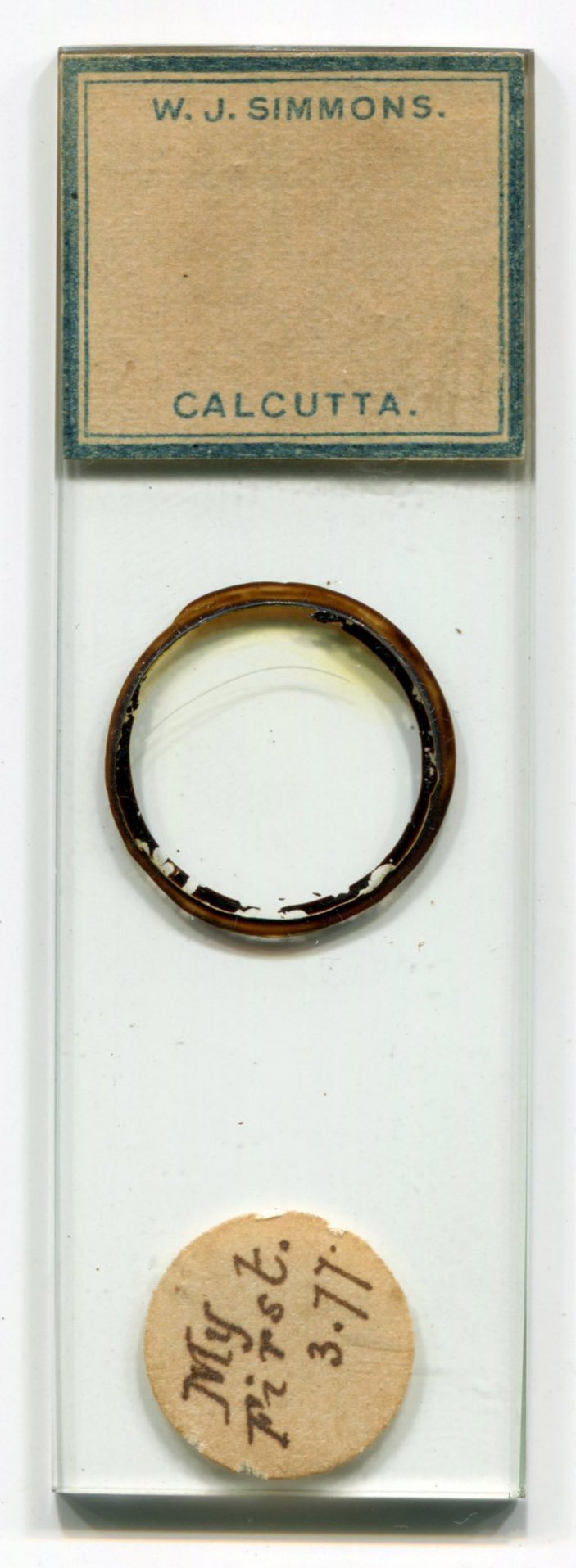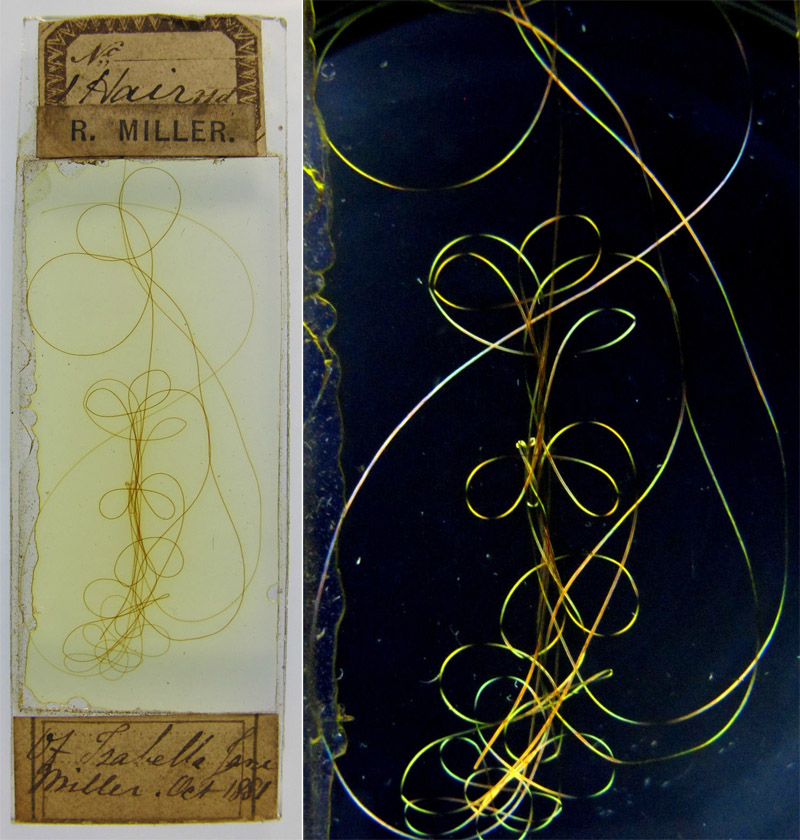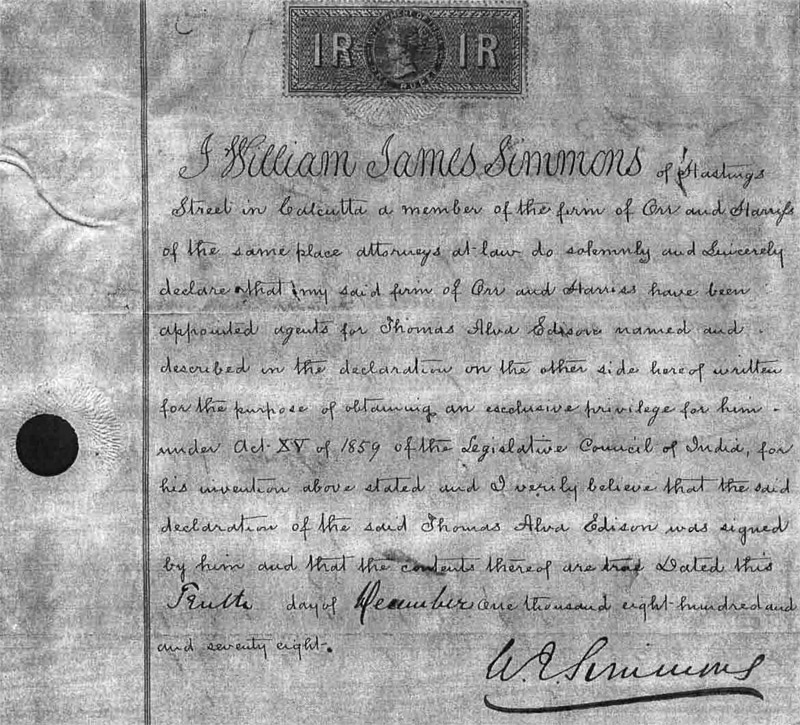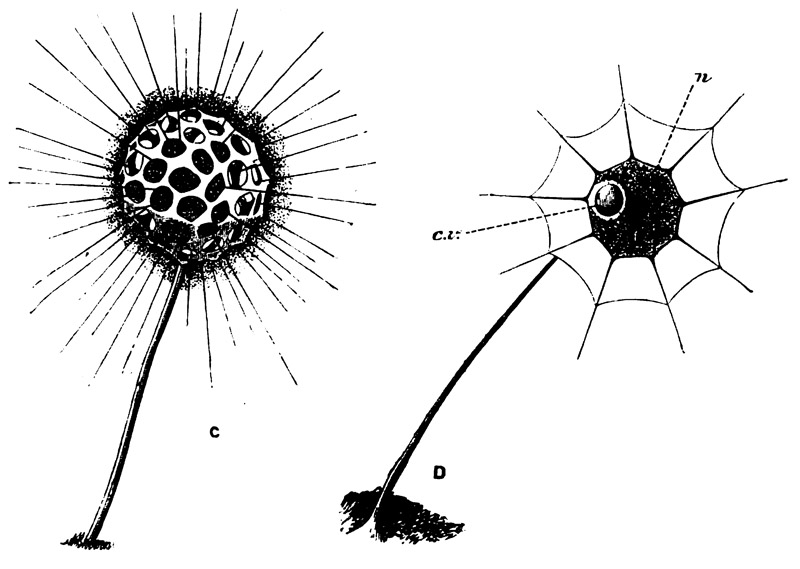
Figure 1. 1877 microscope slide by William James Simmons, of Calcutta, India.
Self Preservation:
An example from William
James Simmons, 1843-1927
by Brian Stevenson
last updated October, 2014
Among a case of assorted microscope slides, one in particular caught my eye: it bears the printed label of “W.J. Simmons, Calcutta”, and a second, handwritten label stating “My First. 3-77” (Figure 1). Victorian-era slides from India are quite rare. I also assumed that this was the first microscope slide that Simmons had made, and I was intrigued to find out what he had put up. But, scanning the slide under a microscope revealed nothing, except a faint, whitish line. After pondering for a few minutes, a thought struck me, and I placed crossed polarizing filters below and above the slide. The result was a rainbow of color from the formerly-white line (Figure 2). W.J. Simmons had preserved his first gray hair!

Figure 1.
1877 microscope slide by William James Simmons, of Calcutta, India.

Figure 2.
W.J. Simmons’ first gray hair, viewed with a 10x objective lens and crossed polarizing filters (polariscope).

Figure 3.
In a similar vein as Simmons’ slide, this is another
hair that was preserved by a different Victorian microscopist. Illustrated are
macroscopic views with normal light (left) and crossed-polarizing filters
(right). Dated October, 1881, this single, extremely long hair came from
Isabelle Jane Miller, and the slide was prepared by R. Miller. Neither Isabelle
nor the preparer have been identified. Pictures from an internet auction site,
reproduced for nonprofit, educational purposes.
Little is known of W.J. Simmons. William James Simmons was born in Fort William, Calcutta, on October 3, 1843, to George James and Anne Elizabeth Simmons. Addresses and society memberships strongly suggest that all of the following information is about that man.
William evidently trained in law, and was a partner in the firm of Orr and Harriss. Notably, Simmons signed an 1878 contract in which Orr and Harriss would arrange marketing in India of Thomas Edison’s phonograph (Figure 4).

Figure 4.
Contract with Thomas Alva Edison, signed by William
James Simmons in 1878.
Simmons left the law firm in 1880. He was later referred to as having an M.D. degree, suggesting that he had some sort of medical training. At the very least, he was involved with issues related to public health.
Simmons actively followed the era’s exciting research on cholera and bacteriology. He sent a cholera specimen to American microscopist J.M. Adams, who wrote in 1885, “I have lately received a remarkably good slide of this interesting object from our microscopical friend, W. J. Simmons, of Calcutta, which he obtained with great difficulty from an assistant of Dr. Koch, who in order to get a genuine specimen applied the cover glass to the mucous lining of the intestine of a cadaver”. Simmons also wrote in 1885 to the English magazine Hardwicke’s Science-Gossip, “Cholera Bacillus - The short notice, at p. 42 of Science-gossip for this year demands attention. Professor Ray Lankester maintains that the comma bacillus is a spirillum. Assuming it to be the cause, either directly or indirectly, of cholera, this view would support those held by persons who regard cholera as an acute fever. But is this spirillum view maintainable? Koch cultivated the comma bacillus successfully. Its action in cultivation fluids is characteristic and marked. The bacillus obtained in fluids was always the comma bacillus. A fragment of a spirillum containing spores would develop into perfect spirilla; but for disintegrated spirilla always to develop into disintegrated spirilla, and for all these disintegrated spirilla to resemble each other, and to be identical with Koch's comma bacillus, does, I think, throw doubt on the accuracy of Professor Lankester's view”.
In 1886, Simmons published a paper on "Air, water, and soil, as affecting health" for the Calcutta Public Health Society.
He helped found the Calcutta Microscopical Society in June of 1887. The Journal of the Royal Microscopical Society noted, “A Microscopical Society has, on the suggestion of Mr. W.J. Simmons, been founded at Calcutta, with an entrance fee and annual subscription of five rupees. It is intended to have two Sessions, one in the cold season and the other in the middle of the year, with a recess after each. Meetings will be held monthly. So far as we know, this is the only Microscopical Society in any part of India. There must be a large and very interesting field for microscopical work in that part of the world, and we wish the new Society every success”.
Simmons found two species of protozoa, Clathrulina elegans and Hedriocystis pellucida, in a water tank. In 1892, he published a paper on the organisms in Hardwicke’s Science-Gossip, which included his drawings (Figure 5).

Figure 5.
Some of Simmons’ drawings of the protozoans Clathrulina elegans and Hedriocystis pellucida, from his 1892 paper.
The American Monthly Microscopical Journal stated, “Calcutta Microscopical Society - At the April meeting Mr. W.J. Simmons described his method of making an observation of dust with a view of detecting in it air-borne spores which are said to cause molds to grow in a manner which the earlier observers believed favored the doctrine of spontaneous generation. The method is simplicity itself, and consists in placing a drop of pure glycerine on the center of a slip of glass measuring three inches by one inch. The drop is smeared over the glass lightly so as to cover a surface of about three-quarters of an inch in diameter, and is then exposed to the air for two or three days. When the dust which settles on the smear is to be examined under the microscope, a circular cover glass is placed on it, and the deposit is now shown by the microscope to be composed of a most heterogeneous collection of objects. Fibers of all sorts, the scales from insects, wings, root, pollen, starch, down, fragments of epidermis, and of the cuticle of plants, hair, entire mites, numberless inorganic particles, charred straw, portions of insects, hairs from plants, and several spores of fungi are thus revealed. If a drop of glycerine, half an inch in diameter, arrests so many spores, how many do we inhale daily, and how many are deposited on our food in the course of a day? The study of dust is not one suited to a beginner in microscopy, because it presupposes familiarity with the thousand and one objects which are certain to be present on the glass slip; but it presents no insuperable difficulties, and does not demand any special or costly appliances”.
Simmons was elected as a Fellow of the Royal Astronomical Society in 1913. He was then also an officer of the Astronomical Society of India. The Monthly Notices of the Royal Astronomical Society noted that, at the time of his election, Simmons was again working as a lawyer.
Resources
Adams, J.M. (1885) The cholera bacillus, The Microscope, Vol. 5, pages 38-40
The American Monthly Microscopical Journal (1896) Note on the Calcutta Microscopical Society, Vol. 17, page 438
Bengal: Past and Present (1907) Minutes of the inaugural meeting of the Calcutta Historical Society, indicating that W.J. Simmons was a member, Vol. 1, pages 1 and 91
Birth record of William James Simmons (1843) Born October 3, 1843, Christened December 24, 1843, accessed through familysearch.org
The Calcutta Law Reports of Cases Decided by the High Court (1880) “That for some considerable time, previous to the 3rd of February 1880, the said Alfred Edmund Harriss and William James Simmons, carried on business as attorneys in copartnership with John Cave Orr under the style or firm of Orr and Harriss. That on the 3rd of February the said firm of Orr and Harriss became dissolved”, Vol. 6, page 406
The Collegian and Progress of India (1913) Note on the “Annual General Meeting of the Astronomical Society of India .. Mr. W.J. Simmons presiding”, Vol. 5, page 80
Death record of William James Simmons (1927) Died October 20, 1927, buried October 23, 1927, accessed through familysearch.org
Hardwicke’s Science-Gossip (1886) Notice on W.J. Simmons’ "Air, water, and soil, as affecting health", Vol. 21, page 162
Insect Life (1888) Discussion of W.J. Simmons’ “Metamorphoses of fleas”, Vol. 2, pages 290-291
Journal of the Royal Microscopical Society (1887) Note on the founding of the Microscopical Society of Calcutta, page 667
Journal and Text of the Buddhist Text Society of India (1895) The list of members attending a meeting includes W.J. Simmons, Vol. 2, page i
Monthly Notices of the Royal Astronomical Society (1913) Election of W.J. Simmons
Puille, Stephan (2002) Congratulations: the 125th birthday of Thomas Alva Edison’s phonograph patent declaration for India, The Record News, pages 7-13
Simmons, W.J. (1885) Cholera bacillus, Hardwicke’s Science-Gossip, Vol. 21, page 163
Simmons, W.J. (1892) Some stalked actinophyrans, Hardwicke’s Science-Gossip, Vol. 28, pages 124-127
Simmons, W.J. (1892) Minute arcellae, Hardwicke’s Science-Gossip, Vol. 28, page 153
Simmons, W.J. (1892) Meteoric dust?, Hardwicke’s Science-Gossip, Vol. 28, page 201
Simmons, W.J. (1897) Earthquake comparisons, letter to the editor of The Englishman, reprinted in The Earthquake in Bengal and Assam, S.N. Banerji, Calcutta, pages 283-285